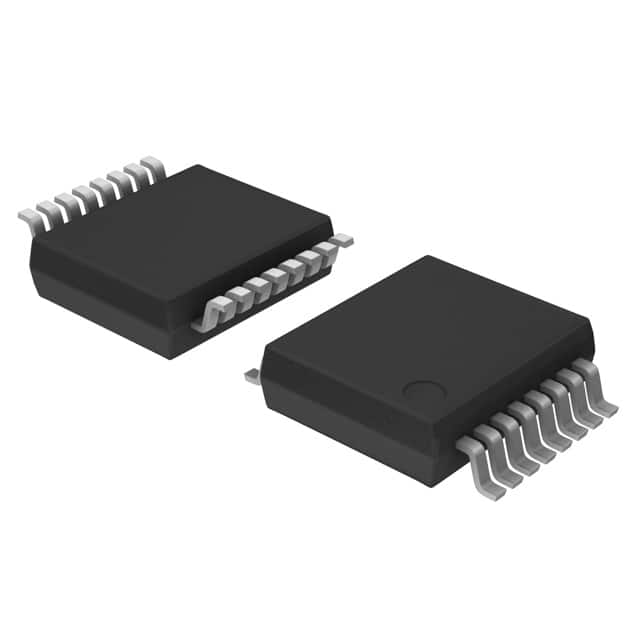PCA9554ADB,118
Basic Information Overview
- Category: Integrated Circuit (IC)
- Use: I/O Expander
- Characteristics: Low-voltage 8-bit I2C-bus and SMBus I/O expander with interrupt output and configuration registers
- Package: TSSOP-16
- Essence: The PCA9554ADB,118 is a versatile I/O expander that provides additional input/output pins for microcontrollers or other devices.
- Packaging/Quantity: Tape and Reel, 2500 units per reel
Specifications
- Supply Voltage: 2.3V to 5.5V
- Input/Output Voltage: 0V to VDD
- Maximum Output Current: 25mA per I/O pin
- I2C-bus Frequency: Up to 400kHz
- Operating Temperature Range: -40°C to +85°C
Detailed Pin Configuration
The PCA9554ADB,118 has a total of 16 pins in the TSSOP-16 package. The pin configuration is as follows:
- SDA - Serial Data Input/Output
- SCL - Serial Clock Input
- A0 - Address Input
- A1 - Address Input
- A2 - Address Input
- INT - Interrupt Output
- P0 - General Purpose I/O Pin 0
- P1 - General Purpose I/O Pin 1
- P2 - General Purpose I/O Pin 2
- P3 - General Purpose I/O Pin 3
- P4 - General Purpose I/O Pin 4
- P5 - General Purpose I/O Pin 5
- P6 - General Purpose I/O Pin 6
- P7 - General Purpose I/O Pin 7
- GND - Ground
- VDD - Supply Voltage
Functional Features
- 8-bit I/O expander with a bi-directional I2C-bus/SMBus interface
- Configurable input or output pins
- Interrupt output for efficient event notification
- Internal power-on reset
- Low standby current consumption
- Noise filter on SDA/SCL inputs for improved performance in noisy environments
Advantages and Disadvantages
Advantages: - Provides additional I/O pins without using extra microcontroller pins - Easy to interface with microcontrollers through the I2C-bus/SMBus - Interrupt output allows efficient event handling - Low power consumption in standby mode
Disadvantages: - Limited number of I/O pins (8 in total) - Requires an external pull-up resistor for the I2C-bus/SMBus lines
Working Principles
The PCA9554ADB,118 is controlled through the I2C-bus/SMBus interface. The microcontroller sends commands and data to configure the I/O pins as inputs or outputs. It can also set the logic levels of the output pins. The interrupt output can be used to notify the microcontroller of any changes on the input pins.
Detailed Application Field Plans
The PCA9554ADB,118 can be used in various applications where additional I/O pins are required. Some potential application fields include: - Industrial automation systems - Home automation systems - Internet of Things (IoT) devices - Robotics - Sensor interfaces
Detailed and Complete Alternative Models
- PCA9554APW,118: TSSOP-16 package, same functionality as PCA9554ADB,118
- PCA9554ARGTR,118: QFN-16 package, same functionality as PCA9554ADB,118
- PCA9554ADGVR,118: TVSOP-16 package, same functionality as PCA9554ADB,118
Note: These alternative models have different package options but offer the same features and functionality as the PCA9554ADB,118.
This entry provides an overview of the PCA9554ADB,118, including its basic information, specifications, pin configuration, functional features, advantages and disadvantages, working principles, application field plans, and alternative models. The PCA9554ADB,118 is a versatile I/O expander that can be used in various applications to provide additional input/output pins for microcontrollers or other devices.
Lista 10 Vanliga frågor och svar relaterade till tillämpningen av PCA9554ADB,118 i tekniska lösningar
Sure! Here are 10 common questions and answers related to the application of PCA9554ADB,118:
1. What is PCA9554ADB,118? PCA9554ADB,118 is a 8-bit I/O expander with I2C-bus/SMBus interface. It provides general-purpose remote I/O expansion for most microcontroller families.
2. What is the operating voltage range of PCA9554ADB,118? The operating voltage range of PCA9554ADB,118 is from 2.3V to 5.5V.
3. How many I/O pins does PCA9554ADB,118 have? PCA9554ADB,118 has 8 I/O pins that can be configured as inputs or outputs.
4. Can PCA9554ADB,118 be used with both 3.3V and 5V microcontrollers? Yes, PCA9554ADB,118 can be used with both 3.3V and 5V microcontrollers as it supports a wide operating voltage range.
5. How is PCA9554ADB,118 controlled? PCA9554ADB,118 is controlled through the I2C-bus/SMBus interface. It uses a two-wire serial interface for communication.
6. What is the maximum frequency supported by PCA9554ADB,118? PCA9554ADB,118 supports a maximum frequency of 400 kHz for I2C communication.
7. Can PCA9554ADB,118 be used for both input and output operations simultaneously? Yes, PCA9554ADB,118 can be used for both input and output operations simultaneously. Each I/O pin can be individually configured as an input or output.
8. Does PCA9554ADB,118 have internal pull-up resistors? Yes, PCA9554ADB,118 has internal pull-up resistors that can be enabled or disabled for each I/O pin.
9. What is the maximum sink/source current per I/O pin of PCA9554ADB,118? The maximum sink/source current per I/O pin of PCA9554ADB,118 is 25 mA.
10. Can multiple PCA9554ADB,118 devices be connected to the same I2C bus? Yes, multiple PCA9554ADB,118 devices can be connected to the same I2C bus by assigning unique addresses to each device using the address pins.


